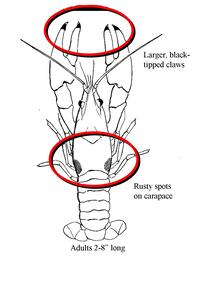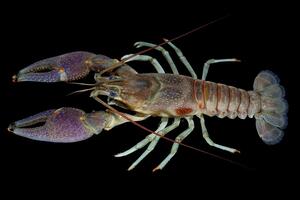Rusty Crayfish
Rusty Crayfish Orconectes rusticus
Where do rusty crayfish come from?
- The normal distribution of the rusty crayfish includes Illinois, Indiana, and Ohio.
- In recent years its distribution has expanded because of the use of live crayfish as bait by anglers.
- The rusty crayfish has not been found in Kansas.
What do rusty crayfish look like?
- Rusty crayfish have large, black-tipped claws.
- Rust colored spots on carapace.
Why are rusty crayfish a problem?
- Rusty crayfish displace native crayfish.
- They destroy plant bed abundance and diversity.
How do rusty crayfish spread?
- Spread by use as bait.
- Females carry fertilized eggs which make spread easier.
How do we control rusty crayfish?
- Learn to identify the rusty crayfish.
- Do not use rusty crayfish as bait.
- Always drain water from your boat, livewell, and bilge before leaving any water access.
- Always dispose of your unwanted bait on land or in the trash.
- Never dip your bait bucket into a lake or river if it has water in it from another waterbody.
- Never dump live crayfish from one waterbody into another.
What do I do if I discover a rusty crayfish?
If you discover a rusty crayfish, freeze it in a sealed plastic bag, note the date and location, and call the Emporia Research Office at (620) 342-0658 or email the Aquatic Nuisance Species Coordinator. Early detection of isolated populations may help prevent their spread. Your help to report new sightings and to prevent their spread is vital.
Images and Recent news
Rusty Crayfish links:









